#coco substrates
Explore tagged Tumblr posts
Text

Looking for the perfect growing medium for your plants? Look no further than Coco Coir from Coastal Coirs Limited! ~ Coco coir is a natural, sustainable, and eco-friendly alternative to traditional soil. Made from the fibrous husks of coconuts, it offers a wide range of benefits for gardeners and farmers alike. ~ First and foremost, coco coir is an excellent soilless growing medium. It is lightweight, well-draining, and has a neutral pH, making it perfect for a variety of plants, from fruits and vegetables to ornamental flowers. ~ But that's not all! Coco coir also has exceptional water retention properties, meaning your plants will never go thirsty. Plus, it's resistant to disease and pests, ensuring your plants stay healthy and strong. ~ What's more, coco coir is a renewable resource. Unlike peat moss, which is often used in traditional soil mixes, coco coir doesn't harm natural ecosystems or contribute to environmental degradation. ~ So why not give coco coir a try for your next gardening project? Your plants will thank you for it, and you'll be doing your part to support a more sustainable future for our planet. ~ Contact us to know more about coco coir pith, WhatsApp : +91 8838166448 (or) https://wa.me/918838166448 Website : www.coastalcoirs.com Mail : [email protected]
#coco coir#coco peat#coir pith#horticulture#hydroponics#growing medium#coco coir pith#gardening#greenhouse#coastal coirs limited#landscaping#coco peat blocks#coir pith blocks#soilless growing medium#coco substrates#peat substrates
0 notes
Text
The Benefits of Using Coco Coir for Successful Mushroom Cultivation
Introduction: Mushroom cultivation is a fascinating and rewarding endeavor that has gained popularity among enthusiasts and commercial growers alike. While mushrooms don't grow in traditional soil, the choice of substrate plays a pivotal role in their growth and development. One substrate that has gained prominence in recent years is coco coir, a natural byproduct of coconut processing. In this blog post, we'll explore why coco coir is an excellent choice for cultivating mushrooms and how its unique properties contribute to successful cultivation.
1. Exceptional Moisture Retention: Coco coir, derived from coconut husks, is known for its exceptional water-holding capacity. This feature is crucial for mushroom cultivation, as maintaining consistent moisture levels is essential for mycelium colonization and subsequent fruiting. Unlike some other substrates, coco coir retains moisture while still allowing excess water to drain, creating an ideal environment for healthy mycelial growth.
2. Optimal Texture: The texture of coco coir is another factor that makes it well-suited for mushroom cultivation. Its fibrous structure provides ample surface area for mycelium to spread and establish a robust network. This is particularly important during the colonization phase when mycelium growth needs a suitable substrate to expand.
3. pH Neutrality and Versatility: Coco coir typically has a near-neutral pH, which can be advantageous when growing mushrooms. It provides a stable starting point for adjusting pH levels to suit the specific needs of different mushroom species. Moreover, coco coir's neutral nature allows growers to customize nutrient supplementation more effectively, creating an optimal environment for mushroom growth.
4. Resistance to Contaminants: Contaminants can quickly derail a mushroom cultivation project. Coco coir's natural composition and structure offer some resistance to common contaminants, reducing the risk of unwanted organisms taking over the substrate. This feature makes coco coir a reliable choice, especially for beginners who are learning the ropes of mushroom cultivation.
5. Eco-Friendly and Sustainable: Coco coir is a renewable resource, making it an environmentally conscious choice for substrate material. As coconut husks are a byproduct of the coconut industry, using coco coir also helps in reducing waste and promoting sustainable practices.
6. Ease of Sourcing and Preparation: Coco coir is widely available from gardening centers, agricultural suppliers, and online stores. It usually comes in a dehydrated form, making it easy to transport and store. When ready to use, it only requires rehydration with water, a straightforward process that saves time compared to preparing other substrates.
Conclusion: In the world of mushroom cultivation, choosing the right substrate can significantly impact the success of your endeavors. Coco coir stands out as an exceptional choice, offering benefits such as optimal moisture retention, texture, versatility, and resistance to contaminants. Whether you're a novice cultivator or an experienced grower, integrating coco coir into your mushroom cultivation journey can enhance your chances of achieving healthy and bountiful harvests.
#Mushroom Cultivation#Coco Coir#Substrate#Mushroom Growing#Mushroom Farming#Fungal Cultivation#Horticulture#Sustainable Agriculture#Moisture Retention#pH Neutrality#Eco-Friendly#Contaminant Resistance#Mycelium Growth#Organic Gardening#Agricultural Sustainability#Gardening Tips#Mushroom Enthusiast#Mushroom Farm#Mushroom Harvest#Mushroom Species
6 notes
·
View notes
Text
so my springtail setups are doing pretty good it seems like , noticed they like bell peppers so I buried some bell pepper scraps in there & BAM they're multiplying<3
#the substrate ive got for them is like. coco coir+sphagnum+charcoal+dead leaves+red lava rock pieces+sand. <3#jess.txt
1 note
·
View note
Text
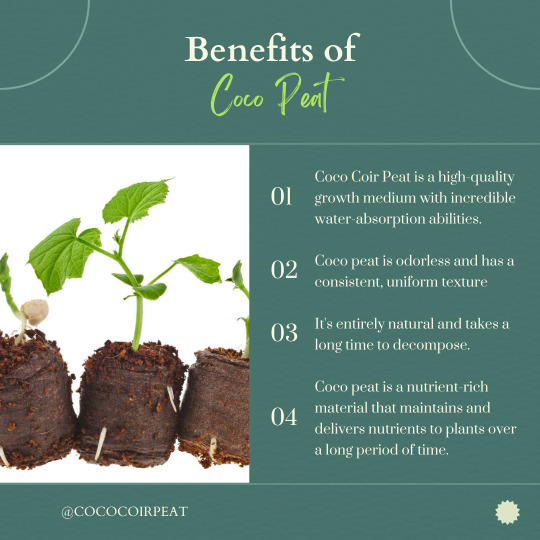
Cultivate your plants the natural way with Coco peat, the key to successful hydroponics farming. Join the eco-friendly movement and experience the benefits of using coco peat in your hydroponics system. Say goodbye to soil and hello to a healthier, more productive harvest, and dive into the world of hydroponics farming with Coco peat
#coco peat#coco pith#coir peat#coco coir pith#coco peat block#garden products#hydroponics#horticultural work#royal horticultural society#coir substrate#floricultural#farming#agriculture#farms#permaculture#agricultural#business#entrepreneurship#startup#industry#b2b#cargo#export#import export business#manufacturing#greenhouses#grow medium#ecofriendly
1 note
·
View note
Text
COCO HUSK CHIP BALES 4.5KG

Coconut husks are sliced into required sizes to obtain coco chips. They have become an important, natural, economical growing medium. They have replaced fir bark in organic agriculture.
https://www.ceyloncocopeat.com/product.php?name=Coco-Husk-Chip-Bales-4.5kg
#Coco peat#Coir Products#Bio Substrate#Coir in Sri Lanka#Grow bag#Coco peat suppliers#Sri Lankan Coconut fiber#Coconut husk#coir products in Sri Lanka
0 notes
Text

this is kinda what i mean btw.
my mice would be in here for .5 seconds, see the moss, and then start digging and pushing it into the blue section or vice versa.
to be fair tho this is a hamster cage and most people who post stuff like this do it for their hamsters...which makes less sense to me bc hamsters burrow way more than mice and yet even hamsters are better behaved when it comes to the substrate?
i dont understand how people can have super cute mouse enclosures with specific bedding depths nd a bajillion things everywhere--
none of my girls give a SINGLE fuck about it and will dig one corner of substrate to the bottom of the tank, therefore burying everything else in a mountain.
#i dont even bother sectioning off areas for different substrate or depths#i dont bother with a coco soil section#bc i know theyre just gonna kick it up into the section i dont want it in anyway
3 notes
·
View notes
Text
Tortoise Storytime!
For most of his life, the scale burger lived in an enclosure that was about 7.5 square feet (~0.7 square meters). This is usually way too small- but he lived in a facility that always had someone on staff, letting him roam the floors while they worked on something nearby.
During covid, I worked at this reptile facility to replace workers who were higher risk and staying home. And I feel deeply in love with this lil bean of a tortoise. He was incredibly vibrant and friendly, was so habituated to humans that he didn't even have an instinct to retract into his shell, and was just flat out adorable.

A year after moving away for my PhD, my old boss reached out to me and asked if I could provide a good home to any of the animals. I instantly asked for this guy.

Unfortunately, I absolutely felt like I made a mistake for a while. I quickly realized that, as busy grad student that worked during the day, I couldn't be letting him roam outside of his small enclosure all the time. For the past year, I've been doing the best I can, experimenting with small enclosures, outdoor time, and floor time to best address his needs. But it always felt temporary and subpar.
As a Russian Tortoise, he has a partial hibernation cycle. For some weird reason, his is inverted with the actual seasons. So when he settled down in the late spring and started pseudohibernation, I could breathe easy for a bit. I left him with some caretakers over the summer, who didn't have much trouble with a sleeping tortoise, and went around having my adventures.
But I knew I wanted something nice waiting for him when he started being active again.
Introducing: the tortoise palace

I had several things in mind for a new enclosure. I wanted it to maximize space in my apartment, maximize my space in my apartment, and have somewhat easy teardown in case I have to move. So, I lifted my bed to be about 4 feet off the ground, and made the enclosure under it. The entire setup is in latched-together pieces that can easily be taken apart and set up again.

I've added climbing enrichment in the form of garden bricks, rocks, and multiple forms of substrate (orchid bark as the main, reptibark, coco coir, and rabbit pellets in deeper dig boxes) but I'll be adding more as time goes on. He's been loving climbing around and I can't wait to see what he'll do with other stuff.

It's an ongoing project, and there's a lot of "temporary solutions that are kinda-permanent" in here, but I'll be fixing those over time. Notably, the walls are pretty low- he can't get out, but I have to be cognizant of putting things he can climb on near the edges. If anyone has any suggestions, I'm all ears! But for now, here's the beast, his unfathomable power just barely contained.
Tiny bit of emotion under the cut.
I know this is dumb. But finishing this genuinely made me cry a little.
I've felt so bad about keeping this guy in what I know is a subpar environment for so long, and doing the best I could to keep him happy and healthy within it. But it was always barely keeping my head above the water.
And now, I finally feel like I have a good, permanent solution to it. This design, by definition, will fit in the space of a full sized bed in any place I live in the future. I feel like I finally provided something good for him. I know he's just a tortoise, but I really do love him, and I love seeing him happy and safe.
Idk. It's all rambles. But thanks for loving and appreciating the wonderful critter he is <3
138 notes
·
View notes
Text
this is an urgent call to those with isopod experience! i just found Stanley sitting next to a woodlouse who was missing both antenna and kept walking in circles.
i’ve made up a small habit for him with coco coir, some substrate, a slate shard and some dead leaves i found and cleaned. i’ve also sprayed him and given him some pumpkin and cucumber chunks.
Does anybody have any advice for me taking care of this lil guy (i’ve called him woody) and any recommendations for food or enclosure stuff?
thank you xx
103 notes
·
View notes
Text
It's hard to overstate just how drastically a change in substrate has improved my sand boa Sok's life
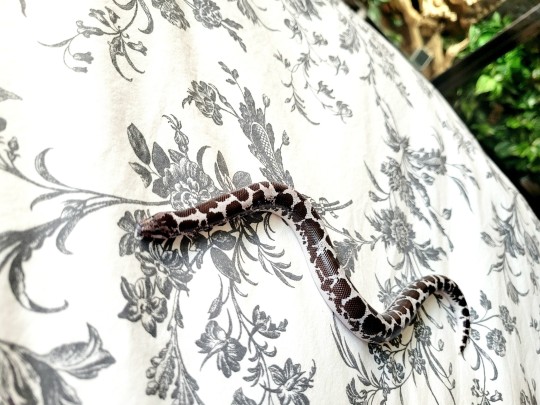
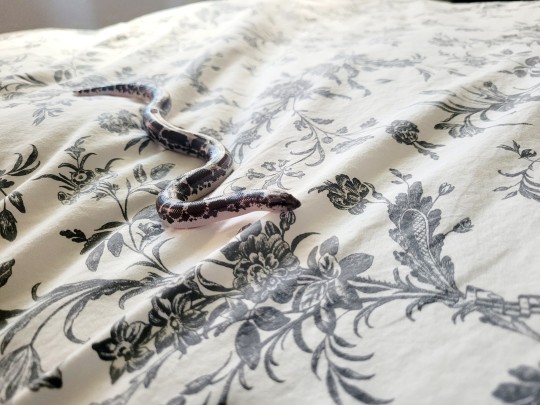
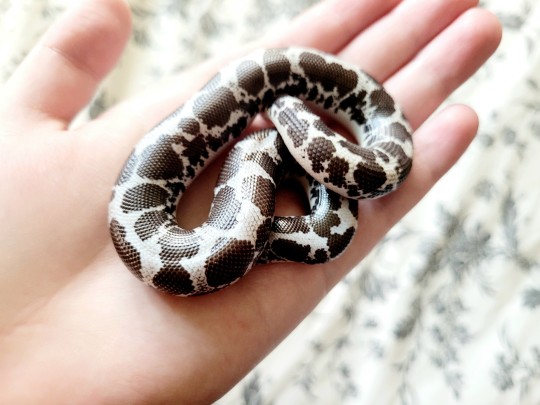

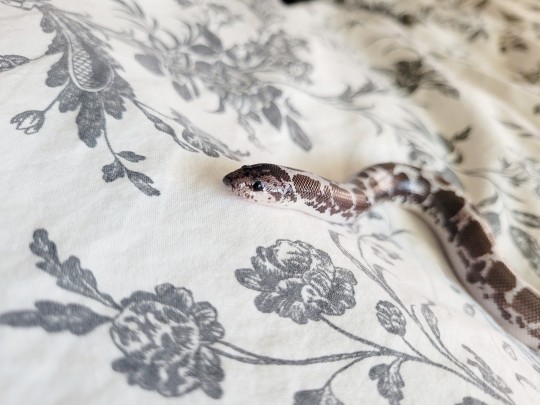

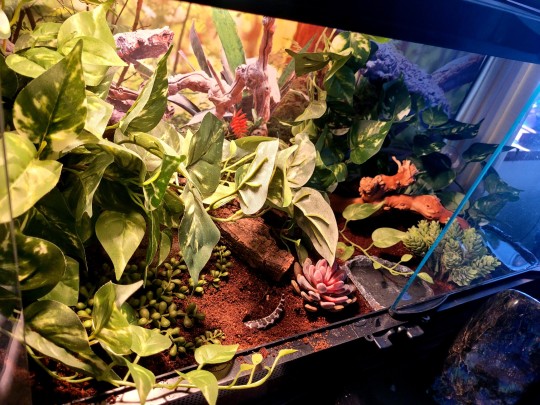
He's gone from being worryingly skinny despite my most attentive efforts to meet his needs on aspen, to the point I was worried I was over feeding him while he was gaining no weight, having terrible stuck sheds despite a humidity box resulting in me having to give him forced hydration periods in a Tupperware with a wet rag... To now, where he's thriving with beautifully healthy scales and naturally heavy-bodied as he should be, on a healthy amount of food almost 1/3 of what he'd been fed previously. He doesn't need to be harassed with the food to eat. He waits with his head poking out of the hole to ambush the f/t mouse on tongs with a healthy appetite. He's easy to handle now, calm and relaxed and sweet.
The best decision I've ever made was switching to 1/4 play sand and 3/4 coco coir with some water poured over top when it dries so it's slightly damp trickling down. Recent developments in research and care suggest the old "sand boa = 20% humidity and literal sand" is not how they are meant to live, and I firmly agree
#sand boa#kenyan sand boa#boa#herpblr#herptile#herpetology#herp#herps#enclosure#reptile keeper#snake#reptile#reptiblr#snekblr#my snek#good snek#snakeblr#sok#oc
197 notes
·
View notes
Text


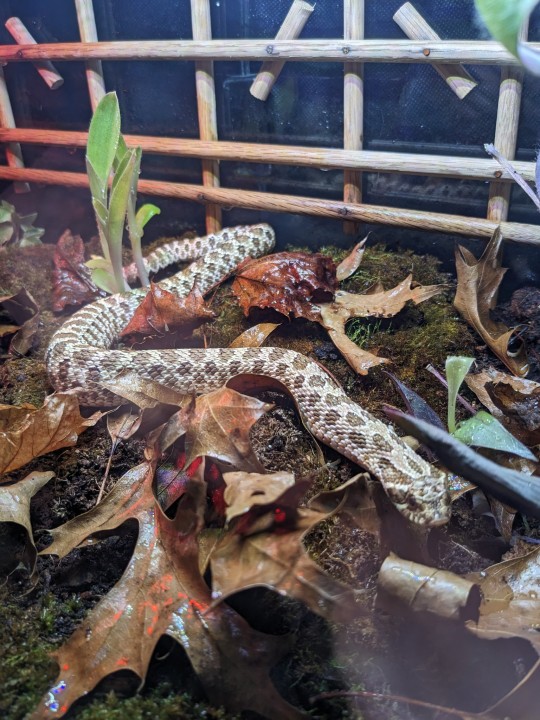
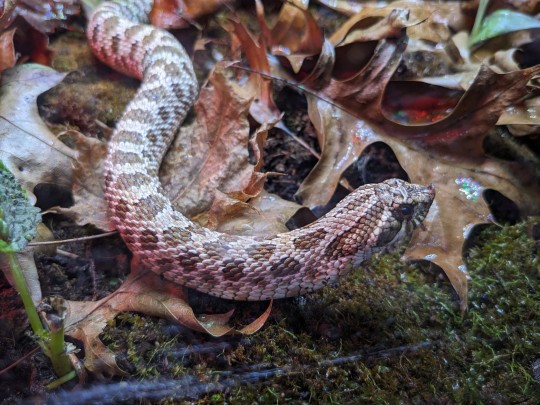
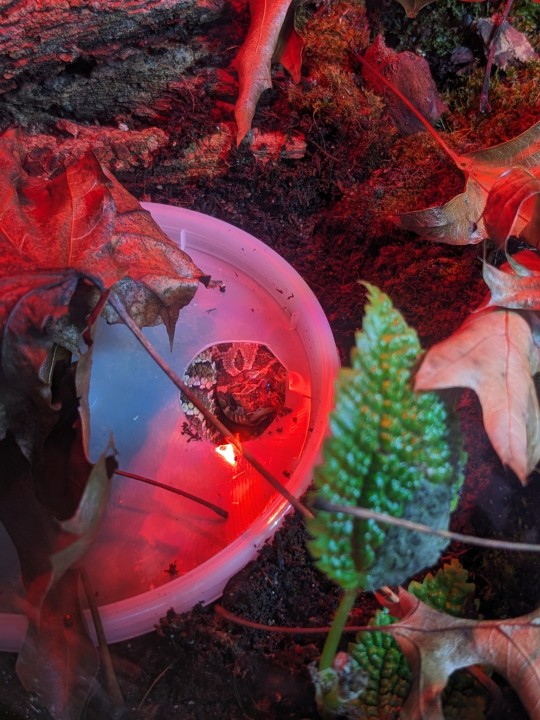
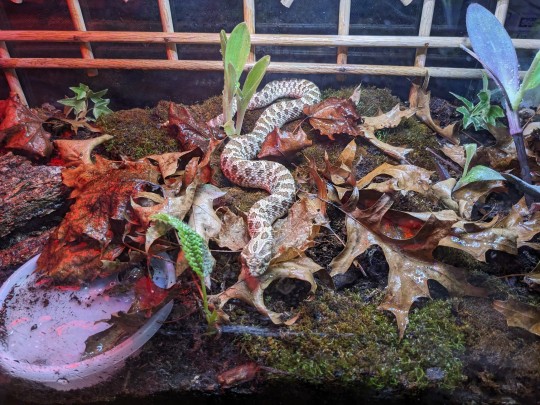
I am briefly holding a hognose for someone that asked me to pick him up at the expo. I don't actually have any snake setups anymore, but this terrarium only has plants, springtails, and some Oreo isopods in it, so I added an underground hide, a water bowl, and a heat lamp for him and put him in. So far he seems to be enjoying it. He dug up a bunch of the substrate (it's mostly coco coir, spagnum moss, and orchid bark chips, this was meant to house animals eventually just not a snake) and basked for a while and took a mouse for me. I miss having snakes, but I know I don't have the time for them. It's still nice to snabysit for a little while!
#snakes#hognose#Longfeather Lane#my pets#i think he might be blind in one eye#and don't worry it's not always that wet#i had JUST watered the terrarium and misted the mosses#it's winter here so that'll dry off by end of day
74 notes
·
View notes
Note
Hey a neighbor just dumped a ball python on me because she didn't think they actually ate mice
So I'm trying to take care of it but it's been a long while since I had a snake and I'm not afraid to ask for help
Do you have any recommendations for substrate and in tank heating?
We currently have what the baby came with , some damp coconut husk and a single low heat bulb lamp.
We're going to update the tank tomorrow or the day after based on how much we have to travel and outfit it but substrate can change a lot based on brand
Sorry for rambling
Oh, oof. I'm so sorry that your neighbor was irresponsible and really glad that that poor snake is in a better situation already. Thank you for taking them in and giving them a chance.
I'm not a ball python expert by any means, so please take what I say with a grain of salt and double-check before you commit to anything.
When I worked in the pet industry (one million years ago!) cypress mulch was the preferred substrate and it can be mixed with coco coir. Coco husk chip on its own is also supposed to be pretty good for higher-humidity species and it's very sustainable.
For heat, I'm a big fan of under-tank heating, but a radiant heat panel or a ceramic heat emitter might be better depending on the enclosure. Light bulbs are an inefficient heat source for snakes and overnight red lights are both inefficient and affect circadian rhythms so I didn't recommend them for reptiles at all.
Just make sure whatever heat source you choose, there's a thermostat to keep it in check.
I hope the snake thrives in your care and that the two of you are fast friends!
#answers to questions#text post#snake#snakes#reptile#reptiles#reptiblr#ball python#ball pythons#snake keeping#snake care#snake husbandry
51 notes
·
View notes
Text

I'm tempted to think my Thai Constellation likes the new substrate 😄 Orchid bark, chunky pumice, coco coir and a bit of perlite. I'm having almost all of my pothos in this mix too and they seem to like it.
#monstera#monstera deliciosa#monstera thai constellation#the only issue with this mix is I'm bad with fertilizing regularly#which is why I put some slow release fertilizer in there usually#and that's not super ideal but mostly it works fine
9 notes
·
View notes
Text
i just realized i havent shown much else of walnut since i got her i should post more pics of her.... maybe when i modify her enclosure a little bit i'll get pics of that
#jess.txt#walnut#i wanna eventually give her a bigger enclosure when i can afford one BUT for now i wanna modify things so the real plant in there#looks like its planted by hiding the pot with some coco fiber & stuff. but i aint gonna actually plant it since she needs an arid substrate#so i dont wanna be watering it & soaking the substrate
1 note
·
View note
Text
Planter Bags

They are made from 100% natural coco chips and coco peat (coconut chips and peat). They are an excellent eco-friendly growing medium in limited space. They are specially designed for organic green houses, home and sky gardening and for any other economical cultivation.
https://www.ceyloncocopeat.com/product.php?name=Planter-Bags
#Coco peat#Coir Products#Bio Substrate#Coir in Sri Lanka#Grow bag#Coco peat suppliers#Sri Lankan Coconut fiber#Coconut husk#coir products in Sri Lanka
0 notes
Text


While I'm working on my Honduran Milks bioactive, I did wanna take the time to talk about Links Bioactive. Link is my overweight[He's working on it! <3] Male Emergency re-home Ball Python. I typically avoid this species, but he's been a fantastic little Unicorn for me. So lets talk about Link's enclosure and how it works! Link is in a 4ft x 2ft x 2ft PVC Enclosure- this is the *minimum* size this species requires to thrive. His substrate is made up of a layer of perlite sitting at the bottom of his enclosure, this layer of perlite acts as a drainage layer. This drainage layer, which catches excess water that seeps through the substrate. It also helps with catching potentially bad bacteria, and helps with your plants roots! The rest of the substrate sitting ontop of that layer of perlite is a mix of Ecogro organic topsoil, Coco fiber, and Sphagnum moss. I cannot stress this enough, but if you choose to do a bio-active enclosure PLEASE be sure to choose a organic substrate!! Fertilized substrate can be toxic to your animal, this includes manure-based fertilizers. To promote healthy growth, I choose to use Coco fiber and Sphagnum Moss. The Coco fibe[Coco peat] Is a safer way to promote healthy soil for both your plant, and your animals, while the Sphagnum Moss is fantastic at holding water and Nutrients for your plants. The arguably biggest and most important part of this enclosure is the cleanup crew. Your cleanup crew will break down decaying plant matter and your animals feces and return it to the soil, as well as cleaning bacteria growth. Bio-actives cannot function in the long-run without a cleanup crew. The cleanup crew I chose consist of Dairy Cow isopods[Porcellio laevis], and Temperate Springtails[Collembola sp.]. You can Mix-and match your Isopods and Springtails as long as its a species that can tolerate the humidity and temps your animal requires, HOWEVER! Its important to note your Isopod species. I chose not to mix Isopods in this enclosure as Dairy cows are kinda known for being aggressive. For plants, ball Pythons are incredibly Bulldozery animals and will trample much of your flora. Needing hardy plants that could survive being trampled and occasionally uprooted was a must for him, and after thought and research, I ended up settling on these: Golden Pothos, Snake plants, and Jade Pothos. Some just overall incredibly hardy plants that, since having them, I've found fantastic success with surviving Links night-time pathing and assaults. I also have a Philodendron [Monstera adansonii,] in there, providing cover and clutter around and over his hot hide. I'm proud of this plant surviving so far, to say I added it with a specific reason would be a goddamn lie lmao I just loved how cool it looked. The fact it's survived and adapted for as long as it has is a miracle in of itself, and I wish great health amongst this trooper of a plant. I deep water once a week to keep my plants healthy and the soil moist enough for my isopods to thrive, with occasional spraying staggered through the week. Overall, this is how Links Bioactive tank is settup! Is this the only way to set up a Bioactive tank? Certainly not! There's plenty of ways you can setup a Bioactive. Does your animal absolutely NEED a bioactive enclosure? For a lot of animals that answers going to be no! It doesn't. Bio-active vs Non-bio-actives have their pros and cons that, maybe Ill ramble about in a later post. And probably talk on what a Bioactive even is and go into much more detail than I did here about how it works. But I chose Bioactive personally because the long-term upkeep is less costly and labor-inducing, and I just love the looks of them. AndICanHaveAsManyGoddamnIsopodsAsIWant<3
#bioactive#vivarium#info dump#biology#ball python#reptile#isopods#plants#I got lazy towards the end and just started saying Bioactive#herpetology#snake#botony#horticulture
65 notes
·
View notes
Text
a blog just for my inverts and snakes (disclaimer 4 any handling pics/videos: handle at your own risk, don't emulate without experience.)
main @cyanocoraxx
🕷 🦂 🩸

⭐pedes: astraeus, akaza, choso, doma, gyomei, guttertank, kokushibo, mindflayer, major, reigen, sunstorm, shrine, sukuna.
click read more for my list of inverts (27/02/25)
⭐ - medically significant venom
⭐? - possibly significant, not enough research

acanthoscurria geniculata - unnamed
aphonopelma sp. jalisco - unnamed
brachypelma hamorii - pleck
ceratogyrus marshalli - kantus ⭐
chilobrachys fimbriatus - hersey ⭐
chilobrachys huahini - unnamed ⭐
cyriopagopoeus lividus - dirge ⭐
haploclastus devamatha - bridgeburner
homeoemma chilensis - iblis ♀ (2015)
lampropelma n. arboricola - tarn
lasiodora parahybana - laios
phormictopus auratus - furnace ♀
poecilotheria subfusca - pepper ⭐
poecilotheria metallica- nacelle ⭐
pterinochilus murinus - reaver ⭐
selenocosmia crassipes - bard

linothele sericata - cupcake (2024)
atypus karschi - hamster (2024)
calommata signata - unnamed (2024)
eresus walckenaeri - gomah (2024)

tailless whip scorpion (damon medius) - mizaru ♂
tailless whip scorpion (damon medius) - kikazaru ♂
tailless whip scorpion (damon medius) - iwazaru ♀
thai vinegaroon (thelyphonus sp. red) - unnamed

scolopendra morsitans (blood red) - sukuna (2024)
scolopendra morsitans (blood red) - shrine (2024)
scolopendra morsitans (dragon head) - major (2024)
scolopendra morsitans - guttertank (2025)
scolopendra subspinipes (java) - choso ⭐ (2024)
scolopendra dehaani (orange) - astraeus ⭐ (2024)
scolopendra mutilans (green) - gyomei ⭐ (2024)
scolopendra polymorpha - sunstorm (2024)
ethmostigmus trigonopodus (yellow) - akaza (2024)
e. austroyunnanensis - kokushibo (2024)
ethmostigmus austroyunnanensis - doma (2024)
ethmostigmus borneo blue - mindflayer (2025)
otostigmus scaber - unnamed (2025)
cormocephalus sp - reigen (2025)

none currently ):

none currently ):

dwarf wood (l. australasiae) - bargie ♀ (2023)
vietnam forest (h. loaticus) - hideous mass (2024)

brazilian rainbow boa - inti ♂ (5-6ft) (2015)
royal python - latte ♂ (4ft)
rosy boa - carmine ♂ (2ft)

"aren't you scared it will bite you" hello job. no i can't come in today. i'm being bitten by my poecilotheria metallica. yeah i'll be off work for 3 weeks. yay
"does it still have its venom" yes. who am i to deny a girl's fun? if she wants to envenomate me one day that's ok with me
"it can't love you" neither could my dad but we move
"why keep centipedes eughghgh gross" i don't have room in my house for an actual dragon so the smaller land ones will do instead
"what do you feed them" small children
"what do you do with them" we vibe. my spiders know my deepest darkest secrets and they will never tell you. on account of being incapable of human speech.
"do they sleep in your bed" yes and they size me up every night. one day they will eat me. please send help!
"how can you sleep at night with those in your house" see above. i'm never alone :)
"can i have some tips on keeping centipedes" YES! the basics are: an escape-proof tub with good cross-ventilation on all sides. no coco fiber substrate, use peat/topsoil/sand in varying amounts depending on if the pede is arid or tropical. varied diet including: raw meats, livefoods, cat food, and some fruits. always remove uneaten food and other rotting things within 24 hrs to avoid harmful gas buildup. don't get bitten. etc. <3
13 notes
·
View notes